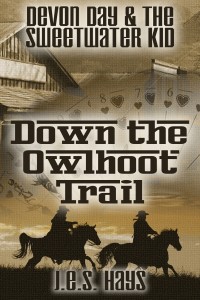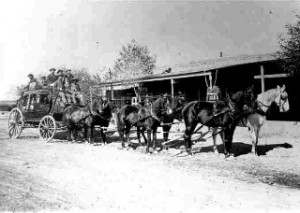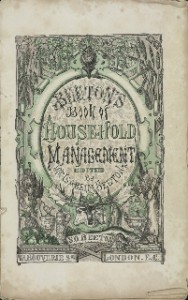This week, I’m part of a Writing Process Blog Tour, where authors talk about their process and why they write what they write.
At the end of this post, I’ll tag three other authors who will post about their writing process on their own blogs next Monday, thus continuing the Blog Tour – follow them as they tell their tales
What am I working on?
DOWN THE OWLHOOT TRAIL is out on the market – available on Amazon and Barnes and Noble, and on the JMS Books website.
I’m now working on a novel featuring Devon Day and the Sweetwater Kid, tentatively titled OUTLAW SECURITY. The lads have succeeded in their goal of becoming the two most successful outlaws West of the Mississippi, and their alter egos of Kye Devon and Chance Knight are two of the wealthiest (and most eligible) young men in San Francisco. They have everything a couple of rogues could ever want — until Federal Agent Kirkham tracks them down! I’m hoping to complete the manuscript to my satisfaction within the year, and start shopping it around.
I’m also working on a short story for the Western Fictioneers’ Wolf Creek series. The anthology is called LUCK OF THE DRAW, and concerns a marathon poker tournament in the fictional town of Wolf Creek. The only thing Chance likes better than robbing the big bugs of the world is playing a rousing hand of poker, so he’ll be there with bells on.
How does my work differ from others in its genre? I think I have more humor than you’ll see in most Westerns. Chance and Kye are wise-acres, and they handle stress by ragging on each other and making smart-ass remarks. It’s also a bit unusual to have your heroes be unrepentant outlaws. These fellows are going to “retire” one day — they know they’re bucking the odds, and aren’t going to keep going more than a few more years — but that’s going to be because of their age and the chances of getting caught. They suffer not a qualm about the morality of what they do.
Why do I write what I do? I’ve always loved Westerns, particularly those with memorable characters, and most particularly where one of those characters is a trickster. The trickster character has fascinated me since childhood, when I first realized that you could use your wits instead of your brawn to solve a problem. All of my stories have a trickster character, though I hope they don’t get into quite as much trouble as some of the traditional tricksters.
I enjoy writing about the Old West because it was a “simpler” time when people were judged on their actions instead of how much money they had or how photogenic they might be. The idea that you had to be polite or risk getting shot is also appealing! The characters who made it out West were tough people, fighting nature as much as each other, and that makes for good story characters. I love the American Southwest, too, and like putting the haunting vistas into my stories.
How does my writing process work? When I’m “in the groove,” I usually get up early and get in half an hour of writing before I start work. On my days off, I try for at least 2,000 words, though if I’m on a roll, I can do more than that. If I’m editing, I try to finish at least one chapter to my satisfaction.
I tend to start at the beginning and write straight through to the end, though I have on occasion jumped right into a scene that fired my imagination. I do a lot of research before I start writing, because I like to get the history right, but I can also find myself surfing the internet during a chapter if I discover something I forgot to look up beforehand. I got halfway through a scene at the lads’ house when I realized I had no real idea what the inside of a typical house in that era would look like. I found an entire book on the subject and downloaded it.
I write using two basic programs: Microsoft Word and Scrivener. I use Word for short fiction and blog articles, just because it’s easy to pull up a new page and save it. Scrivener is great for the novel, because you have so much you can do on it. Character charts, side notes, research articles — they even have “index cards” you can slide around to rearrange your scenes.
A Thank-You tag:
Thanks to the talented Meg Mims for tapping me to join The Writing Process Blog Tour! Meg is the author of the Double Series: Double Crossing and Double or Nothing, (both of which you should read!) and is currently working on a new cozy mystery series with Sharon Pisacreta, writing as D.E. Ireland. The first book, Wouldn’t It Be Deadly, is coming out in September, 2014, and is already available for pre-order on Amazon and Barnes and Noble. Meg also writes for the Western Fictioneers’ Wolf Creek series.
Tag – You’re It!
Thanks for stopping by today to read about my writing process. Now it’s my turn to tag three other authors to talk about their process and why they write what they do. Follow these authors’ posts in the next few weeks. Learn about them and discover a whole host of new books to read
J.M. Kelley – author of Drew in Blue and Daddy’s Girl
Welcome to the Summer Blog Hop! Put on your flip-flops and bathing suits, slather on the sunscreen, and get ready for a great summer of reading. Thanks to Cody Gary of Avon Romance for starting this round robin blog hop. My hostess is Meg Mims– author of Double or Nothing and Double Crossing.
Each author answers five questions about his or her latest release and current WIP. They also post a recipe… hopefully pertaining to their work. Then each author invites five more authors to participate and links them all together.
- When writing, are you a snacker? If so, sweet or salty? I usually don’t snack while writing unless you count the omnipresent latte or Mexican Coca-Cola. When I do snack, it’s usually something salty like peanuts or cheese.
- Are you an outliner or someone who writes by the seat of your pants? And are they real pants or jammies? I like a rough outline, but then I just start writing and see what comes out. Once I get some good bones on my story, I like to return to the outline and make sure I include all pertinent information so I don’t forget that Kye has his pistol at the end of Chapter Three, or that Emily has an Aunt Susie. I’d say I spend about half the time writing in jammies, depending on whether I have the whole day off or have to run errands.
- When cooking, do you follow a recipe or wing it? I use a recipe the first few times, but then I wing it, changing things around to see what tastes best. This can produce some spectacular successes or failures, depending.
- What is next for you after this book? I’m working on a novel featuring the same characters as my anthology. Devon Day and the Sweetwater Kid have realized all of their goals, and are at the top of their game. They have it all – until Federal Agent Stone Kirkham tracks them down. He makes them an offer: go to jail or go to work for his new government agency, solving cases that can’t be solved by strictly legal means. It’s a mystery story set in late 1800’s San Francisco, and features another new character as well: Emily Sharp, eccentric spinster and best friend to our lads.
- Last question … on a level of one being slightly naughty and ten being whoo-hoo steamy, how would you rate your book? The anthology is pretty mild, as it’s written to appeal to both teens and adults, but the novel will have some sexy scenes for the older audience. Nothing X-rated, however
Want to keep hopping? Check out the following websites:
(watch this site for more links)
And now for the recipe – this is from Pioneer Handbooks and you can download it along with a lot of other useful historical information.
How to Make Ice Cream
By John Miller
(Copyright 8/13/1886)
“This book will give full directions in detail how to make Ice Cream, you will have no loss or disappointments, it will tell you how to avoid getting bad Eggs in your Cream, it will tell you which kind are the best Freezers, it will tell you how to make your Custard and how to freeze it, how to keep it frozen, and how to dish it up to the advantage and satisfaction of all concerned.”
To 1 gallon of sweet, fresh milk take 1 dozen of chicken-eggs, 1 ½ pounds clean white sugar, and 1 tablespoon of good white flour. When breaking the eggs, do not break them over the bowl in which they are to be beaten, but break them separately into a tumbler, to avoid getting bad eggs into the bowl. Add a tablespoon or two of the sugar to the eggs, and beat them rigidly until they are thoroughly fine and foam up high. Next dissolve the tablespoon of flour with a little of the milk. Now, after everything is prepared, place the milk over the fire, stir into it the well-beaten eggs, and when the milk is hot add the dissolved flour and the sugar. Stir the milk constantly with a long-handled stout spoon from the bottom up, to keep it from scorching, for if it is allowed to scorch it will be ruined. The custard must remain on the fire until it almost comes to a boil, and begins to get thick and ropy, then remove it from the fire. As soon as the custard is done, in order to free it from all impurities that might have been in the milk or sugar, it is well to strain it through a thin piece of domestic, such as is used for small meal sacks. If in no hurry to freeze the custard, place the vessel containing it into cold water, and allow it to cool first. If the custard should be frozen at once, pour it into the freezer, place the freezer into the tub, and put broken ice around it. Clean off well the cover of the freezer, then remove it, and stir up the custard with a paddle until it is thoroughly cold. Now the custard is ready to be flavored, which may be done with any good flavoring-extract as Lemon, Vanilla or Strawberry, according to taste. To make red, or pink Ice Cream, purchase coloring in the shape of paste, dissolve as much of it as the size of a nutmeg in a little cold water, and strain it through a thin cloth. Stir the coloring well into the custard, the same as the flavoring, after it is thoroughly cold. Cover up well the freezer again. Take out the stopper just over the bottom of the tub, and draw off the water, then replace the stopper again tightly, and cover the ice which remains in the tub with a layer of salt, then put in a layer of ice and salt again, and continue so to put in layers of ice and salt alternately until you reach the top of the can. Turn the can gently around until the ice sinks below the cover, then take a whisk-broom and carefully sweep all ice and salt from the top and sides of the cover and the tub, wipe it also clean with a cloth, now raise the cover partially, and sweep, and wipe again before removeing (sic) it altogether. After the cover is removed, take the wooden paddle, and scrape the frozen cream down from the sided of the can, and stir it up well from the bottom. At first the can will stand tight in the ice packing, but after a while it will become loose, so that it can be turned with the paddle; continue thus scraping, and stirring the cream, and turning the can until the cream is well frozen. Scrape the cream that adheres to the paddle back into the freezer, and cover it up tightly again. Draw off the water again, which has formed by melting ice and salt, and then stop up tightly to prevent any leakage. Fill up the tub again with alternate layers of broken ice and salt, then raise the freezer in the tub from about 2 to 5 inches, according to the size of the freezer, to permit some of the ice to fall under the freezer. Now fill up again with ice and salt, as much as the tub will hold, useing(sic) for the top layer finer broken ice. The freezer is now ready to be wrapped. This must be done well, otherwise the cream cannot be kept well frozen. Proceed in the following manner: Take as many sacks as will be necessary to make a roll thick enough to tightly fill out the space between the can and the tub, rip them open, and place them on the floor in the following manner: The first sack place before you, so as to form the shape of a diamond, with the corners pointing one towards you, one from you, one to the right, and one to the left. The second sack place upon the first one in the same manner, but draw it a little towards you, so that the corner pointing towards you overlaps the corner of the bottom sack about 3 inches. In the same way, put down all the sacks, always letting the upper sack overlap the lower one. Then begin at the corner pointing towards you, and roll up the sacks as tight as possible. This coil of sacks place around the can as soon as the ice has melted down a little, and wedge it into the tub with a broad, wooden wedge and a mallet. Let one end of the coil, the inner one, stick out a little, so as to afford a hold in removing the coil again. This renders the tub airtight, the can stands firm, the tub may be rolled or turned over without any danger, and can be handled with perfect safety while transporting it. The outside of the tub may also be wrapped with a few sacks; it is well to do so in hot weather. To do this fold the sacks to a width corresponding to the higth(sic) of the tub, wrap them around the tub smoothly, and tie securely with a stout string. Cream packed in this manner, will freeze perfectly hard, and will remain well frozen for nearly 24 hours.



